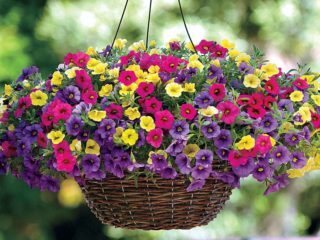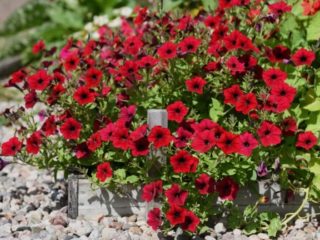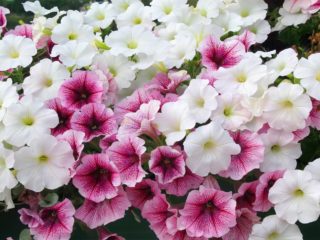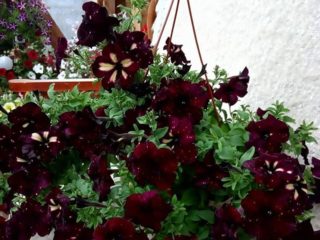Content
All novice gardeners can face a situation where petunia does not bloom. The culture is usually planted in flowerpots and flower beds for long-lasting lush flowering. But sometimes it happens that the desired result is not achieved, and even with a healthy appearance, the plant does not have flowers. There are several reasons for this, and each case has its own ways of eliminating.
How many days after planting petunia begins to bloom
Petunia is a popular garden and indoor plant, has a long flowering period, and is unpretentious to grow. Many gardeners plant it annually on their plots and use it to create landscaping.
In order for flowers to appear on a petunia as early as possible (late May - early June), it is important to know that it has a long growing season. Depending on the variety, at least 2.5 months should pass from the moment of germination to flowering. For this reason, it is advisable to start sowing a plant for seedlings already in winter, in the second half of February. But in this case, it will be necessary to provide the sprouts with additional lighting. Daylight hours should last about 12 hours. If this is not possible, the seeds are planted at the end of March, but then the first flowers should be expected by June.

The frequency of feeding - 2 times a month
How petunia blooms
The culture has the form of bushes, the stems are densely branched, erect or creeping. The height of the plant depends on the varietal characteristics and varies from 15 to 70 cm. The flowers of the petunia are single, funnel-shaped, they are double and ordinary. The color is varied. The flowering period is from the end of May to the onset of frost.
Why petunia does not bloom
Sometimes it happens that the petunia does not bloom after planting. There are several reasons why, at first glance, such a non-capricious plant may not form buds. Even the slightest non-observance of the rules for caring for a crop can slow down its growth and lead to a lack of flowers.
Poor quality soil
An important rule for growing petunias is to provide it with suitable soil. If the foliage of the bushes turns yellow and there is no flowering, then the land in which they grow is probably not of very high quality. For this culture, fertile and loose soil is considered the most suitable. Loams should be enriched with sand, fertilizers, compost or humus. Sandy soil needs the addition of black soil and peat.
If the soil is selected correctly, then the reason for the lack of flowering lies in something else.
Lack of nutrients
Petunia is very fond of fertilizers. Experienced summer residents say that it is advisable to feed it 2-3 times a month for abundant flowering. The culture responds best of all to mineral complexes (Kemira, Pocon, Agricola, Forte). During dressing, it is advisable to alternate watering with useful solutions and spraying.

Rains and lack of sunny days lead to a delay in the development and growth of petunias.
Unfavorable weather conditions
Outdoor petunia often blooms poorly due to bad weather.The number of buds is strongly influenced by rains, lack of sunny days, low air temperature (+20 degrees). Such factors can lead to a stop in development, and even to a lack of flowering.
Lack of light
The plant often suffers from insufficient light, especially for home-grown petunias. With a short daylight hours, its bushes gradually begin to stretch out and form very small buds. The culture needs diffused lighting, lasting at least 12 hours.
Why petunias do not bloom in pots
Blooming problems usually occur in petunias that grow in planters or pots. The reason for this is the lack of strength for growth. The culture has a branched and powerful root system and for normal life it requires a large amount of soil. To grow one sturdy plant, you need a pot of 5 to 8 liters. Moreover, so that the flowers do not suppress each other, the containers should stand at some distance. If the petunia is grown on the balcony, then as it grows it will have to be transplanted, while cutting off the roots:
- the plant, after the first wave of flowering has passed, is taken out of the container;
- the roots and stem are removed by 1/3 part;
- the seedling, after pruning, is placed in new soil and a larger pot;
- sprayed with a growth enhancer and watered.

Potted petunia often does not bloom due to its small capacity
Why petunia stopped blooming
Sometimes it happens that petunia, which bloomed well at the beginning of the season, stops tying buds by the middle of summer. This can be due to several factors that are usually associated with improper care. With the timely correction of the mistakes made, the resumption of flowering can be achieved.
Neglecting the removal of faded buds
If you do not cut off the peduncles that have withered in time, you can damage the flowering of the petunia. The plant will begin to form seed pods, which will cause new buds to set slowly.
Lack of food
If you do not apply top dressing on time or give them in insufficient quantities, petunia will quickly deplete soil resources. This will lead to its poor flowering or its termination. Gardeners are advised to alternate watering with water and fertilizers, while using:
- for growth - feeding with nitrogen;
- for bookmarking flowers - solutions with phosphorus and potassium;
- for a flowering bush - mineral complexes.
Not enough space
Often the reason for the inhibition of cultural development is a small amount of land. Petunias should not be planted close to each other. And if grown in a pot, one bush must be provided with at least 2 liters of capacity. If the planting becomes very dense, then the plants should be thinned out. With insufficient space, development will slow down and flowering will stop. In addition, strong specimens will overwhelm weak ones.

It is necessary to avoid dense planting of plants
Pests and diseases
The plant may stop blooming due to disease or pest attacks. Most often, petunia is susceptible to the following ailments:
- Powdery mildew. Signs of the disease are the appearance of a white bloom with a specific odor on the leaves. With the course of the disease, they begin to fade, curl and fall off. Petunia does not bloom and dies. To cope with the disease, it must be treated with special drugs ("Sulfarid", "Topaz", "Topsin-M").
- Spider mite. A dangerous insect that leads not only to the absence of flowering, but also to the death of the plant. It should be fought with insecticides - "Neoron", "Aktellik", "Fitoverm".
- Whitefly. A pest that feeds on plant sap. In the fight against the parasite, Fitoverm or Aktar can help.
- Aphid. It infects the flower with fungal diseases, which lead to drying and dropping of the buds.Folk remedies and ready-made preparations help to get rid of insects.
How to make petunia bloom
In order for the petunia to bloom for a long time and abundantly, you need to plant a plant and care for it according to the following rules:
- Provide enough space for the root system. Adult specimens have spacious roots, therefore, when planting seedlings, it is important to maintain a distance between each bush of at least 15 cm.When planting ampelous or cascade varieties, the volume of land for one plant should be at least 10 liters.
- Plant petunia in quality soil. The plant requires a breathable, loose soil that is capable of transmitting and retaining moisture. It is good to add wood ash, humus and peat to the soil.
- Water regularly. Petunia does not like drying out of the soil. Bushes that grow in pots or flowerpots should be watered daily, in flower beds as needed. The water should be warm. Watering is carried out strictly at the root.
Warning! Waterlogging and moisture stagnation should not be allowed. Petunia crates should have drainage holes. - Add top dressing. The culture will bloom well only with frequent (once a week) fertilization. You can use complex additives, which include potassium, phosphorus and a little nitrogen. In addition, Ferovit should be added to the soil 3 times per season.
- Form bushes. Almost all varieties of petunias require a neat shape. Cascading and ampelous species - pinch, bush - shear.
- Removing wilted buds. In order for the petunia to bloom abundantly, you should regularly pick off flowers that have withered. If you allow them to form seed pods, then the forces of the plant will be directed not to flowering, but to the development of seeds.

Petunias love spraying with weak solutions of complex fertilizers
What to do if petunia does not bloom well
If the bushes have poor flowering, then you should correctly determine the cause of this deficiency and try to eliminate it:
- When a flower grows in a small pot, you need to transplant it in time.
- For thickened plantings, it is recommended to thin out the flower garden.
- If there is a lack of sunlight, petunias need to be provided with additional lighting or transferred to a brighter place.
- With a lack of nutrients, feed the crop with potash fertilizers.
Conclusion
Petunia does not bloom most often due to improper care. If you follow all the tips for growing it, then there will be no problems with flowering. The plant cannot be classified as capricious crops, but in order to obtain beautiful, healthy and abundantly flowering bushes, certain rules must be followed when breeding it.











